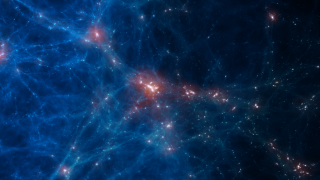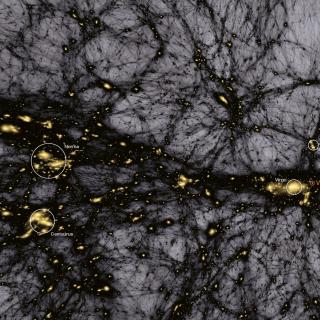Hernández-Sánchez, Mónica; Kitaura, Francisco-Shu; Ata, Metin; Dalla Vecchia, Claudio
Referencia bibliográfica
Monthly Notices of the Royal Astronomical Society
Fecha de publicación:
4
2021
Número de citas
9
Número de citas referidas
8
Descripción
We investigate higher order symplectic integration strategies within Bayesian cosmic density field reconstruction methods. In particular, we study the fourth-order discretization of Hamiltonian equations of motion (EoM). This is achieved by recursively applying the basic second-order leap-frog scheme (considering the single evaluation of the EoM) in a combination of even numbers of forward time integration steps with a single intermediate backward step. This largely reduces the number of evaluations and random gradient computations, as required in the usual second-order case for high-dimensional cases. We restrict this study to the lognormal-Poisson model, applied to a full volume halo catalogue in real space on a cubical mesh of 1250 h-1 Mpc side and 2563 cells. Hence, we neglect selection effects, redshift space distortions, and displacements. We note that those observational and cosmic evolution effects can be accounted for in subsequent Gibbs-sampling steps within the COSMIC BIRTH algorithm. We find that going from the usual second to fourth order in the leap-frog scheme shortens the burn-in phase by a factor of at least ∼30. This implies that 75-90 independent samples are obtained while the fastest second-order method converges. After convergence, the correlation lengths indicate an improvement factor of about 3.0 fewer gradient computations for meshes of 2563 cells. In the considered cosmological scenario, the traditional leap-frog scheme turns out to outperform higher order integration schemes only when considering lower dimensional problems, e.g. meshes with 643 cells. This gain in computational efficiency can help to go towards a full Bayesian analysis of the cosmological large-scale structure for upcoming galaxy surveys.
Proyectos relacionados

Astrofísica Numérica: Formación y Evolución de Galaxias
Entre las cuestiones fundamentales en Astronomía y Astrofísica están la formación y evolución de galaxias. Las escalas de tiempo y tamaño son tan astronómicas que su observación en galaxias individuales es imposible. Solo con el uso de simulaciones numéricas es posible entender la formación de estructuras cósmicas dentro del actual marco
Claudio
Dalla Vecchia

Cosmología con Trazadores de la Estructura a Gran Escala del Universo
El Fondo Cósmico de Microondas (FCM) contiene la información estadística de las semillas primigenias que han dado lugar a la formación de todas las estructuras en el Universo. Su contrapartida natural en el Universo local es la distribución de las galaxias que surgen como resultado del crecimiento gravitatorio de aquellas fluctuaciones de densidad
FRANCISCO SHU
KITAURA JOYANES